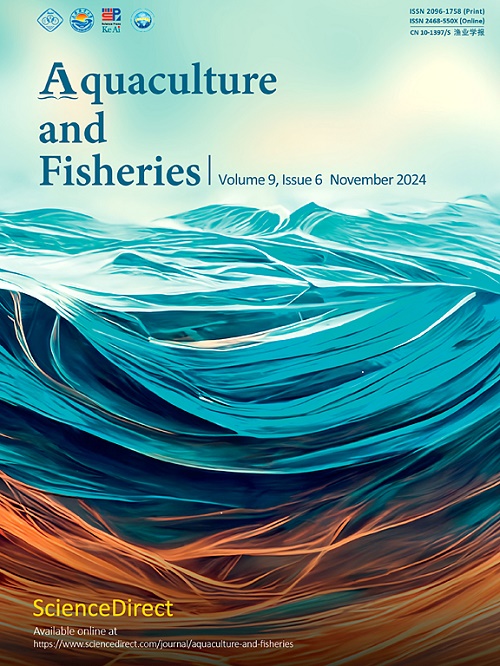黄颡鱼消化系统的组织学形态和基因表达
Q1 Agricultural and Biological Sciences
引用次数: 0
摘要
为了揭示克氏原螯虾消化系统复杂的形态结构和功能方面,本研究采用组织学和转录组测序技术对其消化系统进行了全面分析。调查显示,克氏杆菌的消化系统包括食道、胃(包括心脏和幽门区)、盲肠、中肠、后肠和肝胰腺。食管管腔呈“X”形,可见连接组织内的放射状肌束。胃和肠的内部结构反映了食道的结构。值得注意的是,胃的幽门区域呈现出梳状结构,有助于食物的选择和过滤。盲肠显示肠内较大的管腔,而后肠显示较小的褶皱。代表消化腺的肝胰腺表现出主要的双侧对称特征,包围了两侧的中肠。它由多阶段的分支肝管组成,对消化和吸收至关重要。消化系统转录组学分析显示,在食道、胃、盲肠、中肠、后肠和肝胰腺中有显著的基因表达,分别表达了23,006、22,208、23,485、23,196、22,781和21,375个基因。此外,在161、459、374、547、337和1080个基因中观察到组织特异性表达。此外,447、453、553、506、433和711个基因的子集表现出高表达水平。进一步的分析鉴定出36个消化酶基因,分布在6个不同的消化组织中,分为三组:碳水化合物代谢、脂质分解和蛋白质代谢。综上所述,本研究对克氏杆菌消化系统的形态结构、基因表达特征和消化酶基因分类有了较全面的了解。这些发现为进一步研究克氏杆菌的消化生理和食物消化奠定了基础。本文章由计算机程序翻译,如有差异,请以英文原文为准。
Histological morphology and gene expression in the digestive system of Procambarus clarkii
To unravel the intricate morphological structure and functional aspects of the digestive system in Procambarus clarkii, this study employed histology and transcriptome sequencing techniques for a comprehensive analysis of its digestive system. The investigation revealed that the digestive system of P. clarkii comprises the esophagus, stomach (including cardiac and pyloric regions), caeca, midgut, hindgut, and hepatopancreas. The esophageal lumen displayed an "X" shape, with clearly visible radial muscle bundles within the connecting tissues. The internal architecture of the stomach and intestines mirrored that of the esophagus. Notably, the pyloric region of the stomach exhibited a comb-like structure, which facilitated food selection and filtration. The caeca showcased a larger lumen within the intestines, while the hindgut displayed smaller folds. The hepatopancreas, representing the digestive glands, demonstrated predominant bilaterally symmetrical features, encompassing the midgut on both sides. It consisted of multi-stage branching hepatic ducts, crucial for digestion and absorption. Transcriptomic analysis of the digestive system revealed significant gene expression in the esophagus, stomach, caeca, midgut, hindgut, and hepatopancreas, with 23,006, 22,208, 23,485, 23,196, 22,781, and 21,375 genes expressed, respectively. Moreover, tissue-specific expression was observed in 161, 459, 374, 547, 337, and 1080 genes. Additionally, a subset of 447, 453, 553, 506, 433, and 711 genes exhibited high expression levels. Further analysis led to the identification of 36 digestive enzyme genes across six distinct digestive tissues, categorized into three groups: carbohydrate metabolism, lipid breakdown, and protein metabolism. In conclusion, this study provides a comprehensive understanding of the morphological structure, gene expression characteristics, and classification of digestive enzyme genes in the digestive system of P. clarkii. These findings lay a solid foundation for future investigations on the digestive physiology and food digestion in P. clarkii.
求助全文
通过发布文献求助,成功后即可免费获取论文全文。
去求助
来源期刊

Aquaculture and Fisheries
Agricultural and Biological Sciences-Aquatic Science
CiteScore
7.50
自引率
0.00%
发文量
54
审稿时长
48 days
期刊介绍:
 求助内容:
求助内容: 应助结果提醒方式:
应助结果提醒方式:


